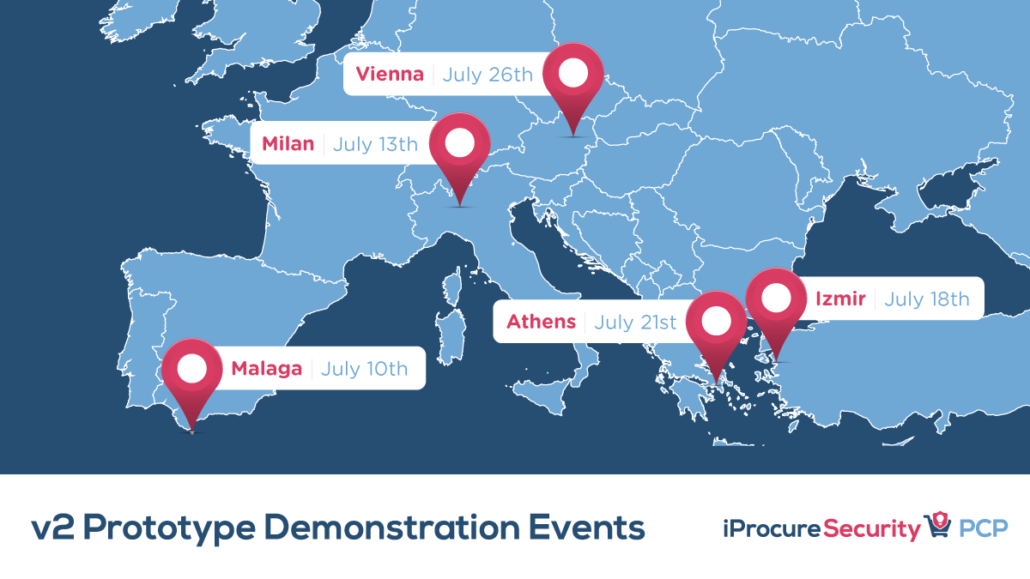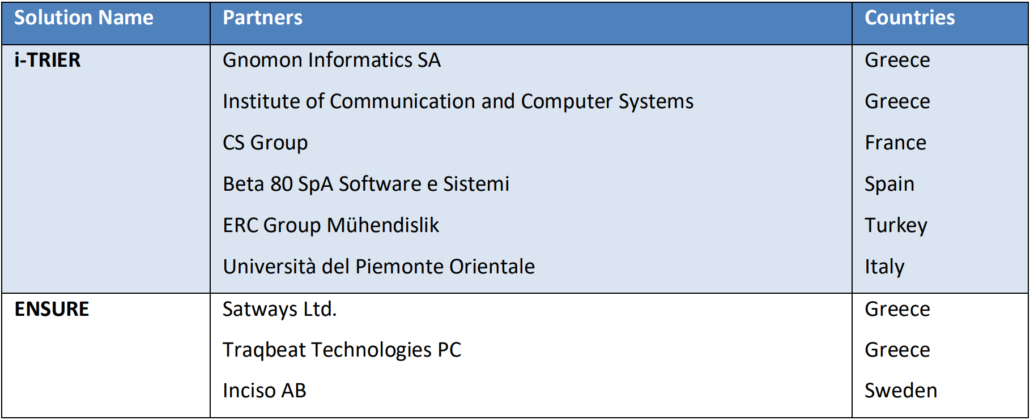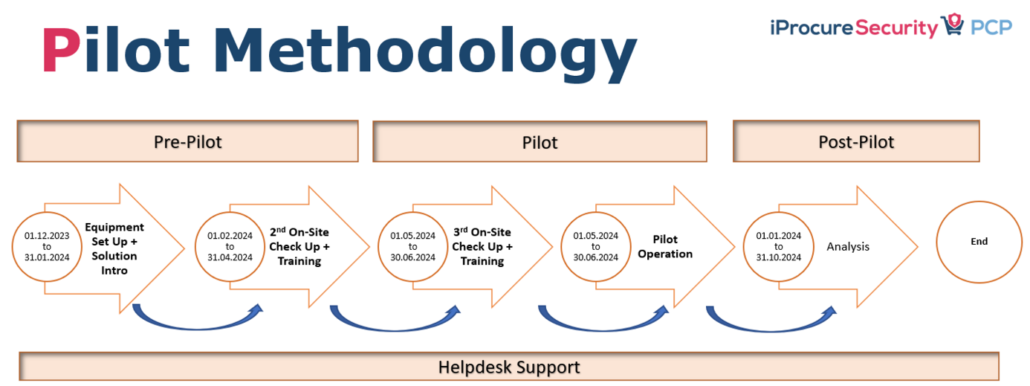 https://www.synyo.com/wp-content/uploads/SYNYO-NEWS-featured-image-NEW01007705EN.png
400
459
leo
https://www.synyo.com/wp-content/uploads/2017/09/synyo-logo.png
leo2025-01-01 10:47:112025-02-10 10:48:51BOND: Outcomes in Advancing Education, Tolerance and Heritage Preservation to combat Antisemitism
https://www.synyo.com/wp-content/uploads/SYNYO-NEWS-featured-image-NEW01007705EN.png
400
459
leo
https://www.synyo.com/wp-content/uploads/2017/09/synyo-logo.png
leo2025-01-01 10:47:112025-02-10 10:48:51BOND: Outcomes in Advancing Education, Tolerance and Heritage Preservation to combat Antisemitism
iProcureSecurity PCP: Implementation of Phase III – Development and Testing of Pilot Systems
Following the successful completion of Phase II – Prototype Development, where the contractors created prototypes of their solutions, the iProcureSecurity PCP project advances into Phase II –Development and Testing of Pilot Systems. Two contractors out of the four from the previous phase have been selected to further develop their prototypes for real-life piloting across the five Public Buyers’ countries – Spain, Italy, Greece, Turkey, and Austria. Phase III started in October 2023 and ends in October 2024.
Completion of Phase II
In Phase II, we embarked on an exciting journey of development and discovery. The four contractors created and presented their prototypes, engaging in two critical iterations:
v1: The first iteration focused on crafting non-functional or partially functional prototypes, which allowed us to gain insights for the solution refinement in the second iteration.
v2: This vital testing phase, conducted in person across all five public buyers’ countries, involved presenting advanced prototypes to a panel of experts and gathering their valuable feedback. The locations and dates for each v2 demonstration are displayed below.

Following the successful completion of Phase II – Prototype Development, where the contractors created prototypes of their solutions, the iProcureSecurity PCP project advances into Phase II –Development and Testing of Pilot Systems. Two contractors out of the four from the previous phase have been selected to further develop their prototypes for real-life piloting across the five Public Buyers’ countries – Spain, Italy, Greece, Turkey, and Austria. Phase III started in October 2023 and ends in October 2024.
Completion of Phase II
In Phase II, we embarked on an exciting journey of development and discovery. The four contractors created and presented their prototypes, engaging in two critical iterations:
v1: The first iteration focused on crafting non-functional or partially functional prototypes, which allowed us to gain insights for the solution refinement in the second iteration.
v2: This vital testing phase, conducted in person across all five public buyers’ countries, involved presenting advanced prototypes to a panel of experts and gathering their valuable feedback. The locations and dates for each v2 demonstration are displayed below.

About the Phase III
In Phase III of the project the selected contractors will further advance their prototypes to a state where they can be piloted under real-life conditions, involving patients, EMTs, and health professional. In each country, the public buyers will select specific scenarios for testing the solutions.
The pilot activities are carefully structured into four essential elements. All the elements are set up in order to enable interaction between public buyers and contractors, and thus to facilitate the exchange of information and the integration of potential existing systems:
- Pilot Preparation
- Pilot Operation
- Pilot Analysis
- Continuous Helpdesk Support

Pilot Preparation
Pilot Preparation during the pre-pilot part involves two key events:
- Equipment Setup and Solution Introduction: In each country, the public buyers allocate two consecutive days for the contractors to install equipment and establish local supplier connections while providing initial system training.
- Second On-Site Check-Up and Training: Following initial setup, the public buyers choose two consecutive days in each country for the contractors to conduct further training and update equipment based on initial feedback, ensuring system readiness for pilot operations.
Pilot Operation
Pilot Operation comprises two key events. Each event is allocated two days in each country:
- Third On-Site Check-Up and Training: This involves critical check-ups and comprehensive training based on previous feedback. The equipment receives updates as needed.
- Pilot Operation: The heart of the pilot phase, this stage demands the operation of all systems at each site, maintaining their quality and functionality. Led by the pilot site management organisation and supported by core team staff, this two-day event per country ensures that the systems operate at their best.
Pilot Analysis
Throughout Phase III ongoing analysis gathers feedback from participants, concluding after the Pilot Operations have ended, which will serve as the foundation for the final report. It primarily focuses on evaluating results from the evaluation questionnaire and comparing them to the DoA KPIs. This analysis is central to Phase III, offering conclusive insights on solution applicability and usability for public buyers.
Helpdesk Support
The continuous Helpdesk Support spanning all stages, will aid contractors and public buyers. It is a dedicated help service that ensures quick issue resolution and maintains site efficiency. The progress is monitored through bi-monthly status calls and a dedicated hotline for seamless communication between public buyers and contractors.
About the two awarded bids
Below are the abstracts of the solutions, that will further develop their prototypes to be piloted under real-life conditions in Phase III:
i-TRIER: I-TRIER brings as a legacy one of the very first fully digitised Triage Solutions, widely adopted Crisis Management System and Computer Aided Dispatch systems, and a unique toolkit of Hospital Management Systems providing interoperability solutions for unifying Emergency and Victim Tracking data domains with the health-data related ones. i-TRIER also brings to the forefront the citizens through the management of their PHR and by securely providing access to it by EMS. A modular, open, interoperable yet strongly integrated solution will be provided, through advancements in existing functionalities both in hardware and software components. i-TRIER will establish a flexible interoperability framework through an efficient streaming mechanism and local exchange of information. Towards the design and testing of the i-TRIER solution, the technology providers will be supported by experts throughout its development stages, ensuring that KPIs related to the MCI response will be improved.
Watch supplier insights about Phase II from i-TRIER here.
ENSURE: The ENSURE system aims at strengthening the response of Emergency Medical Services (EMS) and Responders (EMR) to Mass Casualty Incidents (MCIs). The latter are called to operate under stressful and uncertain environments, given that MCIs are usually evolved in complex and confusing situations. In the first phase of the project, the consortium is designing a novel digital triage system by utilising the unique expertise of Satways, Traqbeat and Incision. By leveraging hands-on experts’ experience in emergency medicine (Incisio), the project will combine medical wearables (Traqbeat) with an emergency management system (Satways) into a novel digital triage system for MCIs. In a disaster event, the system will enable the quick prioritisation of those who need high medical attention by automatically recognising and continuously monitoring their vital signs via an attachable patch from the disaster location to the hospital.
Watch supplier insights about Phase II from ENSURE here.
Stay updated, and subscribe to the iProcureSecurity PCP Newsletter.
Links
https://pcp.iprocuresecurity.eu/
Keywords
Pre-Commercial Procurement, PCP, Triage Management Systems, Emergency Medical Services, Solution Design, Prototype Development, Pilot Operations, Call for tenders Results, Innovation Needs, Innovation Procurement, Disaster Management, Technology, Innovation, Helpdesk Support




